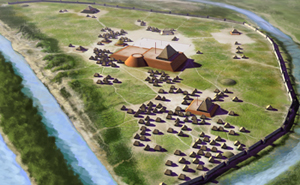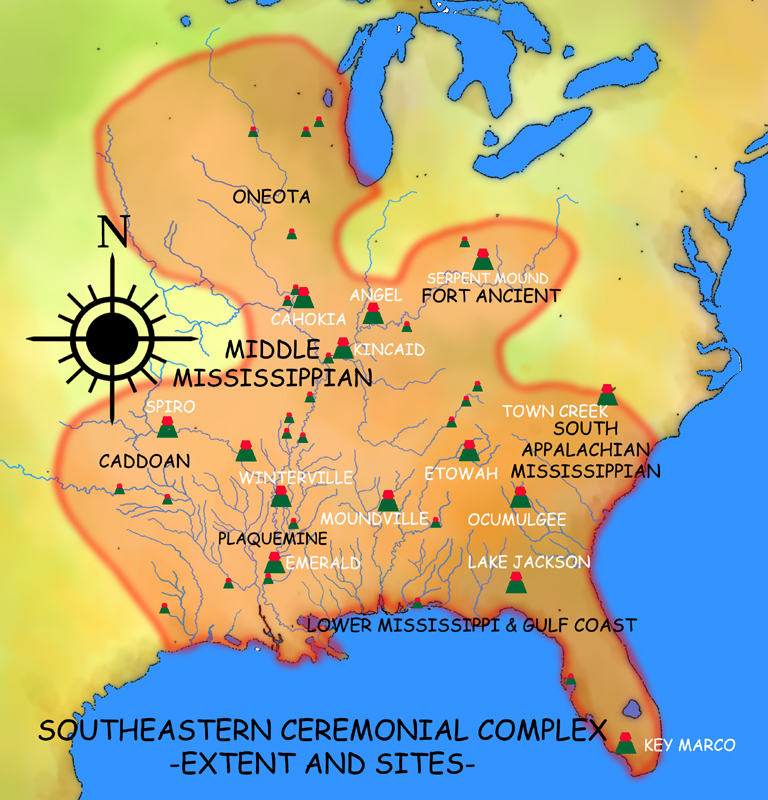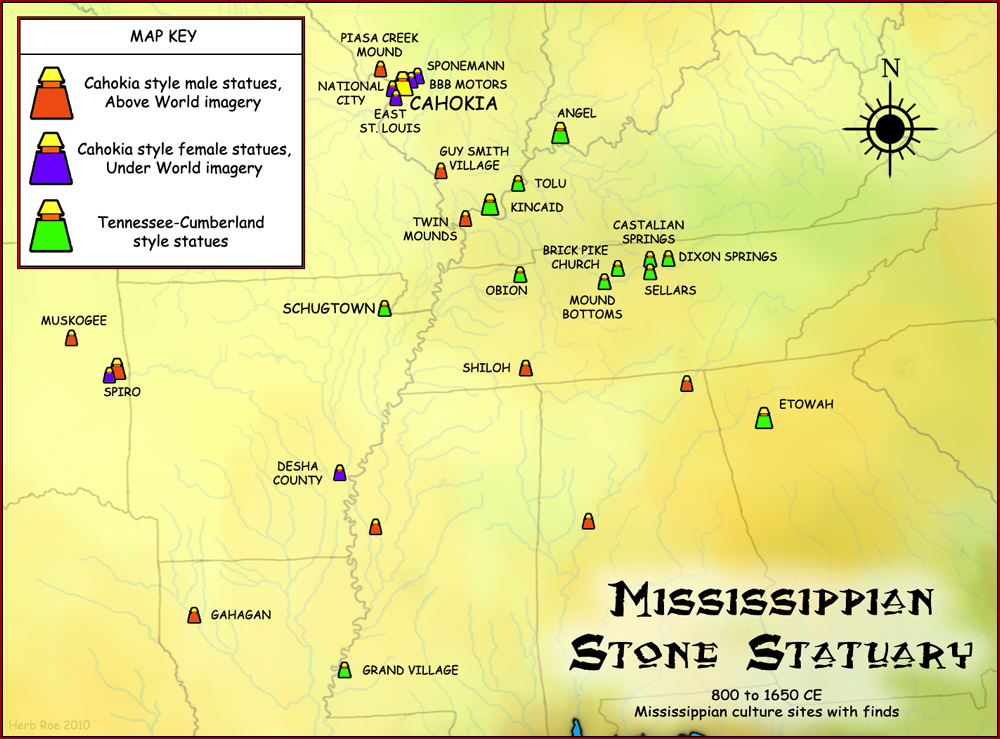|
Turk Site
The Turk Site ( 15CE6) is a Mississippian culture archaeological site located near Bardwell in Carlisle County, Kentucky, on a bluff spur overlooking the Mississippi River floodplain. Site The site was occupied primarily during the Dorena Phase (1100 to 1300 CE) and into the Medley Phase (1300-1500 CE) of the local chronology. Its inhabitants may have moved from the Marshall Site, which is a slightly older settlement located on the nearest adjacent bluff spur. For a regional administrative center, Turk is a small site, but this is because of constraints placed on it by the geography of the bluff spur it sits on. The layout of the site is characteristically Mississippian, with a number of platform mounds surrounding a central plaza. The earliest published investigation at the site was that of Robert Loughridge, published in 1888; the most extensive work at the site was conducted under Richard Edging and published in 1985.Sussenbach, Tom, and R. Barry Lewis. ''Archaeological In ... [...More Info...] [...Related Items...] OR: [Wikipedia] [Google] [Baidu] |
Bardwell, Kentucky
Bardwell is a home rule-class city in and the county seat of Carlisle County, Kentucky, United States. The city was formally incorporated by the state assembly in 1878. The population was 714 at the 2020 census, down from 723 in 2010. History Bardwell was founded in 1874 when a predecessor rail line of the Illinois Central Railroad was extended to that point. It may have initially been known as "Crittenden" after Governor John J. Crittenden, but that name was already in use elsewhere in the state, so the name was changed to "Bardwell." According to some sources, "Bardwell" was the name of a railroad superintendent whose name had been applied to a railroad construction camp near the town site. Other sources suggest the name was inspired by a "boarded well" at the camp. During their session of 1877–1878, the Kentucky General Assembly passed an act incorporating Bardwell. The original municipal boundaries consisted of a circle with a radius of , centered on the local train st ... [...More Info...] [...Related Items...] OR: [Wikipedia] [Google] [Baidu] |
Champaign, Illinois
Champaign ( ) is a city in Champaign County, Illinois, United States. The population was 88,302 at the 2020 census. It is the tenth-most populous municipality in Illinois and the fourth most populous city in Illinois outside the Chicago metropolitan area. It is included in the Champaign–Urbana metropolitan area. Champaign shares the main campus of the University of Illinois with its twin city of Urbana. Champaign is also home to Parkland College, which serves about 18,000 students during the academic year. Due to the university and a number of well-known technology startup companies, it is often referred to as the hub, or a significant landmark, of the Silicon Prairie. Champaign houses offices for the Fortune 500 companies Abbott, Archer Daniels Midland (ADM), Caterpillar, John Deere, Dow Chemical Company, IBM, and State Farm. Champaign also serves as the headquarters for several companies, the most notable being Jimmy John's. History Champaign was founded in 1855, ... [...More Info...] [...Related Items...] OR: [Wikipedia] [Google] [Baidu] |
Archaeological Sites On The National Register Of Historic Places In Kentucky
Archaeology or archeology is the scientific study of human activity through the recovery and analysis of material culture. The archaeological record consists of artifacts, architecture, biofacts or ecofacts, sites, and cultural landscapes. Archaeology can be considered both a social science and a branch of the humanities. It is usually considered an independent academic discipline, but may also be classified as part of anthropology (in North America – the four-field approach), history or geography. Archaeologists study human prehistory and history, from the development of the first stone tools at Lomekwi in East Africa 3.3 million years ago up until recent decades. Archaeology is distinct from palaeontology, which is the study of fossil remains. Archaeology is particularly important for learning about prehistoric societies, for which, by definition, there are no written records. Prehistory includes over 99% of the human past, from the Paleolithic until the advent of ... [...More Info...] [...Related Items...] OR: [Wikipedia] [Google] [Baidu] |
Mounds In Kentucky
A mound is an artificial heap or pile, especially of earth, rocks, or sand. Mound and Mounds may also refer to: Places * Mound, Louisiana, United States * Mound, Minnesota, United States * Mound, Texas, United States * Mound, West Virginia * Mound Creek, a stream in Minnesota * Mounds, Illinois, United States * Mounds, Oklahoma, United States * The Mound, a street in Edinburgh, Scotland, linking the Old Town and the New Town * The Mound railway station, a former station in northern Scotland Arts, entertainment, and media * Mound, a fictional entity in the work of artist Trenton Doyle Hancock * ''The Mound'' (novella), a 1940 work by H. P. Lovecraft Other uses * Mound, monumental earthwork mound built by prehistoric Mound builder (people) * Mound Laboratories, a nuclear laboratory in Miamisburg, Ohio that was a part of the Manhattan Project * Mounds (candy), a candy bar * Pitchers mound A baseball field, also called a ball field or baseball diamond, is the field upon which t ... [...More Info...] [...Related Items...] OR: [Wikipedia] [Google] [Baidu] |
Middle Mississippian Culture
The Mississippian culture was a Native American civilization that flourished in what is now the Midwestern, Eastern, and Southeastern United States from approximately 800 CE to 1600 CE, varying regionally. It was known for building large, earthen platform mounds, and often other shaped mounds as well. It was composed of a series of urban settlements and satellite villages linked together by loose trading networks. The largest city was Cahokia, believed to be a major religious center located in what is present-day southern Illinois. The Mississippian way of life began to develop in the Mississippi River Valley (for which it is named). Cultures in the tributary Tennessee River Valley may have also begun to develop Mississippian characteristics at this point. Almost all dated Mississippian sites predate 1539–1540 (when Hernando de Soto explored the area), with notable exceptions being Natchez communities. These maintained Mississippian cultural practices into the 18th century. C ... [...More Info...] [...Related Items...] OR: [Wikipedia] [Google] [Baidu] |
List Of Mississippian Sites
This is a list of Mississippian sites. The Mississippian culture was a mound-building Native American culture that flourished in what is now the Midwestern, inland-Eastern, and Southeastern United States from approximately 800 CE to 1500 CE, varying regionally. Its core area, along the Mississippi River and its major tributaries, stretched from sites such as Cahokia in modern Illinois, the largest of all the Mississippian sites, to Mound Bottom in Tennessee, to the Winterville site in the state of Mississippi. The typical form were earthwork platform mounds, with flat tops, often the sites for temples or elite residences. Other mounds were built in conical or ridge-top forms. The culture reached peoples in settlements across the continent: Temple mound complexes were constructed also in areas ranging from Aztalan in Wisconsin to Crystal River in Florida, and from Fort Ancient, now in Ohio, to Spiro in Oklahoma. Mississippian cultural influences extended as far north and w ... [...More Info...] [...Related Items...] OR: [Wikipedia] [Google] [Baidu] |
Southeastern Ceremonial Complex
The Southeastern Ceremonial Complex (formerly the Southern Cult), aka S.E.C.C., is the name given to the regional stylistic similarity of artifacts, iconography, ceremonies, and mythology of the Mississippian culture. It coincided with their adoption of maize agriculture and chiefdom-level complex social organization from 1200 to 1650 CE. Due to some similarities between S.E.C.C. and contemporary Mesoamerican cultures (i.e., artwork with similar aesthetics or motifs; maize-based agriculture; and the development of sophisticated cities with large pyramidal structures), scholars from the late 1800s to mid-1900s suspected there was a connection between the two locations. But, later research indicates the two cultures have no direct links and that their civilizations developed independently. Obsolete names for this ceremonial complex, found in some anthropological sources, include Buzzard Cult and Southern Death Cult. Theories and names The complex operated as an exchange network. ... [...More Info...] [...Related Items...] OR: [Wikipedia] [Google] [Baidu] |
Mississippian Stone Statuary
The Mississippian stone statuary are artifacts of polished stone in the shape of human figurines made by members of the Mississippian culture (800 to 1600 CE) and found in archaeological sites in the American Midwest and Southeast. Two distinct styles exist; the first is a style of carved flint clay found over a wide geographical area but believed to be from the American Bottom area and manufactured at the Cahokia site specifically; the second is a variety of carved and polished locally available stone primarily found in the Tennessee-Cumberland region and northern Georgia (although there are lone outliers of this style in other regions). Early European explorers reported seeing stone and wooden statues in native temples, but the first documented modern discovery was made in 1790 in Kentucky, and given as a gift to Thomas Jefferson. History Archaeologists have divided what is known about Mississippian culture religious practices into three major "cult" manifestations. The '' Ch ... [...More Info...] [...Related Items...] OR: [Wikipedia] [Google] [Baidu] |
National Register Of Historic Places Listings In Carlisle County, Kentucky
This is a list of the National Register of Historic Places listings in Carlisle County, Kentucky. It is intended to be a complete list of the properties on the National Register of Historic Places in Carlisle County, Kentucky, United States. The locations of National Register properties for which the latitude and longitude coordinates are included below, may be seen in a map. There are 5 properties listed on the National Register in the county. Current listings See also * List of National Historic Landmarks in Kentucky * National Register of Historic Places listings in Kentucky This is a list of properties and historic districts in Kentucky that are listed on the National Register of Historic Places. There are listings in all of Kentucky's 120 counties. The locations of National Register properties and districts ... References {{Carlisle County, Kentucky Carlisle * ... [...More Info...] [...Related Items...] OR: [Wikipedia] [Google] [Baidu] |
University Of Illinois
The University of Illinois Urbana-Champaign (U of I, Illinois, University of Illinois, or UIUC) is a public land-grant research university in Illinois in the twin cities of Champaign and Urbana. It is the flagship institution of the University of Illinois system and was founded in 1867. Enrolling over 56,000 undergraduate and graduate students, the University of Illinois is one of the largest public universities by enrollment in the country. The University of Illinois Urbana-Champaign is a member of the Association of American Universities and is classified among "R1: Doctoral Universities – Very high research activity". In fiscal year 2019, research expenditures at Illinois totaled $652 million. The campus library system possesses the second-largest university library in the United States by holdings after Harvard University. The university also hosts the National Center for Supercomputing Applications and is home to the fastest supercomputer on a university campus. The u ... [...More Info...] [...Related Items...] OR: [Wikipedia] [Google] [Baidu] |
Plaza
A town square (or square, plaza, public square, city square, urban square, or ''piazza'') is an open public space, commonly found in the heart of a traditional town but not necessarily a true geometric square, used for community gatherings. Related concepts are the civic center, the market square and the village green. Most squares are hardscapes suitable for open markets, concerts, political rallies, and other events that require firm ground. Being centrally located, town squares are usually surrounded by small shops such as bakeries, meat markets, cheese stores, and clothing stores. At their center is often a well, monument, statue or other feature. Those with fountains are sometimes called fountain squares. By country Australia The city centre of Adelaide and the adjacent suburb of North Adelaide, in South Australia, were planned by Colonel William Light in 1837. The city streets were laid out in a grid plan, with the city centre including a central public square, Vict ... [...More Info...] [...Related Items...] OR: [Wikipedia] [Google] [Baidu] |
Carlisle County, Kentucky
Carlisle County is a county located in the U.S. state of Kentucky. As of the 2020 census, the population was 4,826, making it the fourth-least populous county in Kentucky. Its county seat is Bardwell. The county was founded in 1886 and named for John Griffin Carlisle, a Speaker of the United States House of Representatives from Kentucky. It remains a prohibition or dry county. Geography According to the U.S. Census Bureau, the county has a total area of , of which is land and (4.8%) is water. The county's western border with Missouri is formed by the Mississippi River. Adjacent counties * Ballard County (north) * McCracken County (northeast) * Graves County (east) * Hickman County (south) * Mississippi County, Missouri (west) Demographics As of the census of 2000, there were 5,351 people, 2,208 households, and 1,574 families residing in the county. The population density was . There were 2,490 housing units at an average density of . The racial makeup of the county ... [...More Info...] [...Related Items...] OR: [Wikipedia] [Google] [Baidu] |


.jpg)





